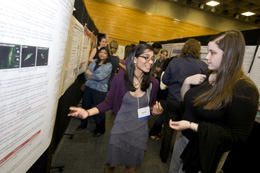Students Team with Faculty on Research to Improve Life in Garden State
Aresty undergraduate researchers will present their work at an April 29 symposium
Doing research that benefits the citizens and businesses of New Jersey is an important part of the university’s mission, a lesson not lost on students participating in the Aresty Research Center for Undergraduates.

The student research covers such concerns as helping people with asthma breathe easier, cutting household energy use, and examining policies that affect how immigrants live and work in New Jersey’s municipalities.
Begun in 2004, the Aresty research program gives students the opportunity to learn research principles and techniques, and then proceed to conduct their own research under the mentorship of a faculty member. The program is named for the late Jerome Aresty, a Rutgers alumnus, and his wife, Lorraine, who provided initial funding.
The 420 students presenting their results during this year’s symposium in the Livingston Student Center testify to the popularity of the program and its importance as an undergraduate offering.
Greg Jackson, interim director of the Aresty Center, cheerfully acknowledges the program’s growth but says it’s just as important to expand the type of students who enroll. “We want to continue increasing our disciplinary diversity,” said Jackson, who is also an associate professor of English in the School of Arts and Sciences. “The Aresty structure originally seemed more geared toward science, because lab work fit the paradigm we set up. Now faculty from a range of disciplines – the natural sciences, social sciences and humanities – are thinking outside the box, imagining how they might incorporate Aresty research assistants in their research programs. That’s the way we’d like to keep growing.”
While undergraduate students have always been able to do independent research by making arrangements with professors on their own, the Aresty program provides a formal multi-year structure that includes funding and peer mentorship. Toward the end of their first year at Rutgers, students apply to work as research assistants in their sophomore year. In this role, a participating professor mentors them closely in the principles and techniques of research. Then during their remaining undergraduate terms, they conduct defined research projects based on student interest and mentor expertise.
“Usually, the student projects splinter off of the professor’s research,” said Jackson. “The professor says, ‘I wish we knew how this enzyme worked in this situation, but that’s outside the purview of my experiment,’ and the student says, ‘Well, what if I find out?’”
Students also find the program to be valuable preparation for graduate school, because the gain insight and experience in the tasks that go along with research, such as lab operations and grant writing.
Following are profiles of some Aresty student projects that involve New Jersey people, communities, and businesses.



Media Contact: Robin Lally
732-932-7084 x652
E-mail: rlally@ur.rutgers.edu